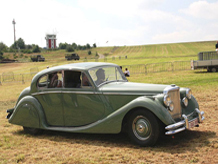Historical Overview

Mark V (1948-1951)
The Mark V was introduced to distributors and the press on 30 September 1948 and launched on 27 October 1948 at the London Motor Show at the same time as the XK120, with which it shared a stand. The XK120 stole the show. However, the Mark V vastly outsold the XK120 by roughly 5,000 cars per year as compared to 2,000 cars per year for the XK120.
While the XK120 had a new overhead-camshaft XK engine, the Mark V retained the 1946-48 driveline including the overhead-valve pushrod straight-6 2½L and 3½L engines, now since 1946 produced by Jaguar, which the company had previously purchased from the Standard Motor Company before the war, and the four-speed single-helical gearbox produced by both Jaguar and the Moss Gear Company of Birmingham. The 1½L Standard engine used in previous models was not offered in the Mark V. Claimed power output in this application was 104 bhp (78 kW) for the 2664 cc Mark V and 126 bhp (94 kW) for its more popular 3486 cc sibling.
The chassis was new with independent front suspension by double wishbones and torsion bar, an arrangement that would be used by Jaguar for many future vehicles. It also had hydraulic brakes, which Jaguar had been slow to adopt compared to other manufacturers, and an all pressed steel body.
The styling of the car followed prewar SS-Jaguar lines with upright chrome grille and the leaping Jaguar radiator cap mascot became available as an option. There is a distinct hint of the recently modernised Bentley look in the style of the front grill.
The wheels were 16-inch (410 mm) steel-disc type, significantly smaller than the 18-inch (460 mm) wheels on the MK IV. Rear-wheel spats (fender skirts) were standard. There was also a drophead coupé version.
A 3½ litre car tested by The Motor magazine in 1949 had a top speed of 90.7 mph (146.0 km/h) and could accelerate from 0–60 mph (97 km/h) in 20.4 seconds. Jaguar's inimitable test engineer Norman Dewis used a Mark V regularly.
When asked about the top speed he saw in his car, he commented that he verified 90 mph once, but the thrill of the moment did not encourage repeating the feat. A fuel consumption of 18.2 miles per imperial gallon (15.5 L/100 km; 15.2 mpg‑US) was recorded. The test car cost £1263 including taxes.


 Jaguar MARK V
Jaguar MARK V
























